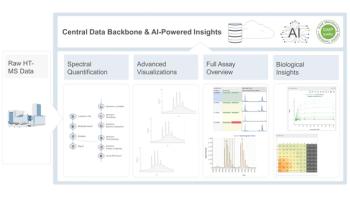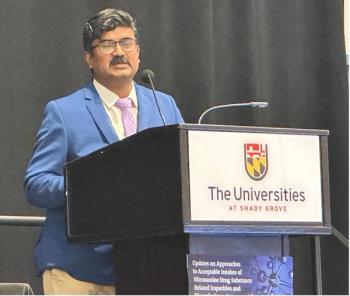Key Points
- Virus-like particles (VLPs) can mimic the form and size of virus particles while lacking the genetic material needed to infect host cells.
- To efficiently optimize human immunodeficiency virus type 1 (HIV-1) VLP purification, broad knowledge about the physical characteristics is required.
- The researchers in this study focused on characterizing chromatin in their clarified HIV VLP supernatant.
- When combined with anion-exchange chromatography as a single chromatographic step, optimized nuclease treatment offered a viable approach for purifying HIV VLP models.
TH Köln and Sartorius Stedim Biotech GmbH researchers based in Germany modified anion-exchange chromatography (AEX) to optimize nuclease treatment of HIV-derived virus-like particles (VLPs). Their research was published in the Journal of Chromatography B (1).
Virus-like particles (VLPs) are virus-derived structures made up of at least one molecule with the ability to self-assemble, mimicking the form and size of virus particles while lacking the genetic material needed to infect host cells (2). VLPs elicit strong cellular and humoral immune responses against various viral pathogens, providing a high safety profile, and are viral nucleic acids-free. Enveloped VLPs can also serve as display platforms, presenting on the surface of surrounding membranes. The most frequently employed viral core proteins are the Group-specific antigen (Gag) proteins of the retroviridae family.
To improve downstream process strategies, the scientists chose a human immunodeficiency virus type 1 (HIV-1)-derived prototype membrane enveloped Gag VLP as a bald VLP model. To efficiently optimize HIV VLP purification, broad knowledge about the physical characteristics is required. A key challenge in producing enveloped virus particles is to fulfill the purity requirements of regulatory authorities. The United States Food and Drug Administration (U.S. FDA) requires final products to contain less than 10 ng of host cell DNA per dose, with a maximum DNA fragment size of 200 bp. Fulfilling these quality criteria requires the application of methods for the qualitative and quantitative analysis of DNA fragments that can also be adapted to chromatin. DNA and chromatin can impede HIV VLP purification with anion-exchange chromatography (AEX), co-eluting in the same fractions as the VLPs.
In this study, the researchers focused on characterizing chromatin in their clarified HIV VLP supernatant. Two DNA subpopulations were identified: a main large fragment population and a minor population consisting of short fragments below 200 bp. According to their findings, the larger DNA fragments presented the primary challenge to their processes, since these fragments co-elute with desired VLPs. To remove long DNA fragment populations, nuclease treatment procedures were optimized using a Design of Experiment (DoE) approach, which deals with planning, conducting, analyzing, and interpreting controlled test to evaluate factors that control the value of a parameter or a group of parameters (3). The DoE approach was used to adjust the treatment to digest DNA in spite of its having tight chromatin structure.
DNA was efficiently digested by the nucleases Benzonase, Denarase, and M-SAN, with over 90% of present DNA being removed (while MNase performed inadequately). Nuclease treatment with low and high Denarase concentrations was applied to clarified HIV VLP harvest samples prior to AEX purification. Notably, in spite of the nuclease treatment, not all DNA was recovered during the step gradient, indicating that some DNA remained bound to the membrane after the chromatography step. Further, while no DNA was detected in the later fractions of the nuclease treatment samples, histone H3 was still eluted, potentially indicating that chromatin may be a source of these histones. By partially occupying the binding sites for the HIV VLPs, either DNA or chromatin might attenuate the HIV VLPs’ bonding strength to the membrane.
Overall, when combined with AEX as a single chromatographic step, optimized nuclease treatment offered a viable approach for purifying the HIV VLP model, providing a platform for the rapid downstream processing of therapeutic VLP candidates. In the future, the researchers hope this method can be validated with actual VLP vaccine candidates to ensure there are no potential effects on immunogenicity. Optimizing the gradient will be further crucial to maximize yield and confidently meet FDA criteria.
References
(1) von Elling-Tammen, M. S.; Taft, F.; Thom, V.; et al. Optimizing Nuclease Treatment to Enhance Anion Exchange Chromatography of HIV-Derived Virus-Like Particles. J. Chromatogr. B 2025, 1256, 124539. DOI: 10.1016/j.jchromb.2025.124539
(2) Nooraei, S.; Bahrulolum, H.; Hoseini, Z. S.; et al. Virus-Like Particles: Preparation, Immunogenicity and Their Roles as Nanovaccines and Drug Nanocarriers. J. Nanobiotechnology 2021, 19, 59. DOI: 10.1186/s12951-021-00806-7
(3) What is Design of Experiments (DOE)? American Society for Quality 2025. https://asq.org/quality-resources/design-of-experiments (accessed 2025-5-28)






